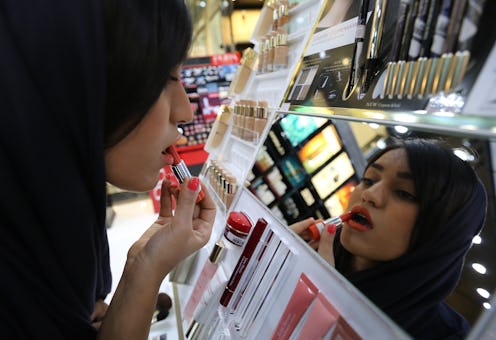Fashion
Exactly When You Should Throw Out Old Cosmetics
News flash: cosmetics get old. You might not have been aware of this (or you might have been judiciously ignoring it) for the simple reason that makeup companies aren't obliged by law to put a use-by date on their products. Which strikes me as odd: surely, if something's got built-in obsolescence, they'd want you to go out and buy more, rather than letting your lipstick pool into an unguent mass at the bottom of your clutch? Not so much.
The good news is that freshness calculators for your makeup now exist on the Internet. As long as you have the batch code, a number printed on the product identifying what batch it was in at the factory, and the month when you opened it, you can look up the official recommendation on its shelf life. The drawback to this is that it's based on unreliable information, and can occasionally be wrong. So we've got to make do on our own.
You should know there are products that you need to throw out more regularly than others. Anything to do with your eye region needs to be kept up to date, otherwise you risk being that woman on the news who gets an infection from old mascara. And anything you've shared should be thrown in a bin yesterday. But throw-outs don't have to be all bad news: brands like Kiehls and MAC have trade-in policies, and if you've made your own cosmetics, they can last for ages.
If you want to keep your makeup for as long as possible, store it in a cool place, thin it out in application, keep everything clean and sanitized — and throw it out after the dates listed below.
Mascara
This one shocked me slightly: Four months is the regularly quoted time limit for mascara. Even if you don't use it that much. Even if it's expensive. I know, it barely seems worth it. Maybe we should all invest in eyelash curlers?
Lipstick
Did you know lipstick can actually go rancid? The good news is that it may be possible to extend the 2-3 year lifespan of lipstick by keeping it in a container in the fridge. The science behind cooling cosmetics is pretty solid: the lower the temperature, the less rapid the chemical reactions that break down the lipstick and turn its oils sour. However, many lipsticks haven't been tested on whether they can cope with being regularly refrigerated and then reheated again (they tend to 'sweat' oil), so check the specifics of the ones you've got at home before throwing them in the veggie crisper.
Eyeshadow
Shadows are pretty faithful: provided you clean the brushes regularly, they can last over three years. Expired powders are hard to spot, but it's best to check for texture change and flakiness, and if you've had an eye infection, say goodbye.
Foundation
The good news is that most of us use up foundations and concealers before they go bad, over a period of 6-12 months. The key sign to look for to know when it's past due? When the makeup starts to separate. A tip to avoid bacteria spread is to avoid touching the nozzle or top as much as possible, dripping it onto your open palm instead.
Lip Gloss
Gloss's distinctive texture is due to its combination of oily emollients and thickening waxes or clays, and it's those two parts that are at risk of going bad. Oxygen gets to both elements and changes them to a gloopy, dry, smelly mess. Expect lipgloss to need to be replaced every two years, less if you regularly leave it somewhere where the temperature fluctuates, like a car.
Eyeliner
The key thing to remember here is that you shouldn't only sharpen eyeliner pencils when they go blunt: Regular sharpening is necessary to keep them bacteria-free — and you should make sure your sharpener is clean too. A pencil can last up to two years, but throw it out immediately if you've had pinkeye or any other kind of infection recently.
Liquid eyeliners? Sorry: if it's one of the ones you apply with a wand, it's got the same short shelf life as mascara, up to only four months. To avoid this, find one that works as a self-contained eyeliner pen.
Powder & Blush
Powder-based makeup is one of the best bets for a long-lasting investment: they can go for three years or longer. They're not invincible, though. The best way to make them last — other than patting the pressed powder back into place with rubbing alcohol if you drop the pot — is to regularly clean and change your applicators, from brushes to sponges.
Nail Polish
If the bottle's been open two years, you'd better throw it out. Runniness is key: the older and more exposed to air polish gets, the thicker and more difficult to spread it becomes. You can thin it out if you like, but once it gets to the point where it's separated and won't rejoin again, it's time to say goodbye.
Images: Giphy
